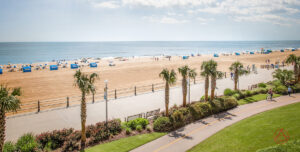Summer is here at last. And in some areas of the country, it’s in full swing. That means long days, early sunrises, and late sunsets. It means afternoon thunderstorms and morning fog.
And it means we need to pay special attention to our drones and the gear we use to run them. And it means we need to pay special attention to ourselves.
Taking care of ourselves is the easy part. Stay hydrated, wear sunscreen, and don’t let the insects get ahold of you. Wear bug spray. And we have to watch out for the creepy crawly critters too. In the South we have chiggers. Nasty little guys can drive you crazy. And all over the country we have snakes and other biting annoyances. Wear boots and use rubber bands around your pant legs.
And look into getting a cooling towel for you neck. Keep it wet, and it will keep you cool. You can find them on Amazon.
Now, if only it were that easy to take care of our drones…
Let’s start with batteries. As hopefully we all know, batteries hate heat. And summer is full of it by definition. Don’t leave your batteries inside a car in the summer. If you’re parked in the sun, it can easily get to be over 150°F inside your car. That’s homicide on batteries.
If you have to keep them in your car, use a cooler, and keep freezer packs in there. But if you use freezer packs, make sure you keep as much moisture as possible out of the cooler. And even then, don’t leave the cooler in the car too long. And check it constantly. Park in the shade, and/or use windshield shades. Leave your windows down a tad. Or, it you’re working from your car and are staying near it, leave them all the way down.
Basically, do everything you can to keep your batteries cool.
And when it comes time to charge your batteries, make sure they’ve cooled off first. Many batteries come with a system that requires them to be at a certain temperature before they’ll charge. But don’t rely on that. charging a hot battery can lead to serious issues.
If you’re able to, discharge your batteries if you don’t plan on using them for a number of days. Leaving batteries at a full charge can damage them. A few of us have set our auto-discharge to 3-5 days. Some of us discharge after every job unless a new job follows the next day or day after.
What else needs to stay cool?
If you’ve ever flown with a tablet in Phoenix in August, that’s an easy question to answer. And it’s not specific to PHX. Any place with high heat can wreak havoc on tablets. If you fly with one, look into getting a Hoodman hood for it. There are other brands, but in our experience, none work better. Check out their offerings here. And no, DSPA does not get a cut of this, we only suggest something that works. Having a Hoodman over your tablet keep the sun from beating down on it, and keeps it demonstrably cooler.
Also, look into having a backup tablet. Finding a used one is cheap insurance. Telling your client you have to wait until your tablet cools down isn’t going to make them happy.
Dirt and grime.
And speaking of Hoodman, also check out their landing pads. Summer brings dirt and dead grass. If you don’t have a clean place to launch from, a landing pad can help keep the dirt out of the motors. Vic, Kenji, & Scott use them constantly. There are other brands as well, just make sure they have weighted edges. Prop wash will flip them easily.
The drone itself is susceptible to over heating.
Many control apps from manufacturers allow you to check the temperature of your batteries. Use that feature to keep an eye on things. Unless the drone is in the air, keep it under shade, or under a light colored cloth. Having a quick pop-up 10’x10’ tent is also a good idea. For the drone and the drone team.
DJI, Skydio, and Autel all have their operating range top out at 104°F. So that must be the magic number. And remember, that’s standing temperature. If your drone is sitting in the sun, it’s soaking up heat. Don’t let an external ambient temperature of 98°F fool you. It’s going to hit that magic 104°F temperature inside the drone very quickly.
This is also where having a back up drone system is a good idea. Switch them out. Fly one for a couple of batteries, then, instead of changing batteries on the third landing, change drones. Then put the one that just flew in a cool place.
Another word of warning about handling the drone in hot weather. DON’T TOUCH THE MOTORS! If you’re like us, you check the props during each battery change. And if you’re like us, you may grab the motor housing to keep it steady while you do so. Don’t. And if you must, wear gloves while doing it. Those housings get very, very hot. Hot enough to leave a mark. Warn your VOs and clients too.
Keep an eye on the sky.
Summertime brings some wicked and fast moving thunderstorms. Especially in fly-over country and tornado alley. Thunderstorms create massive downdrafts and updrafts. Severe wind disturbances can travel from 10-20 miles beyond the body of the clouds. Keep an eye on the trees and ground between you and the cloud base. If you see movement, land.
And those downdrafts from a few miles away can create horizontal ground winds that will hit you out of nowhere.
Now let’s talk about lightning.
You’d think this would be drilled into you in grade school, but we seem to forget. Lightning can kill you. As in dead. As in “but did he get the shot” being asked at your funeral by your now former client.
In extreme cases, lightning can travel up to 100 miles from the storm itself. Pay attention. And remember, you can only hear lightning from around 10 miles away. There were 20 people killed by lightning in 2019. Only 5 were female. Take what you want away from the 3:1 gender ratio gentlemen…
Time of day.
Obviously it’s going to be cooler in the AM at sunrise (& the light will be nicer). So if you can, plan those flights in the AM hours. But obviously that’s not always possible.
That noontime light is great for mapping, but can be a killer on equipment and flight crew.
Plan accordingly.
Humidity
Humidity can cause all sorts of issues on equipment (& crew). Electronics and moisture do not play nice together. If your drone is hot, don’t take it into a cool humid room. The humidity will condensate on the electronics, and if it’s bad enough, short them out. Batteries too.
Those droplets of water can also be attracted to your camera lens. While it may be no big deal to use a lens cloth and wipe it off, it’s not so easy with the internal elements are wet. And pay attention to your sensor. Especially if you have a camera with interchangeable lenses. Moisture (& dust) can get on your sensor very easily.
Finally, let’s talk a little about altitude density.
After all, it was likely on your initial 107 test. There is a reason some planes can’t take off in the summer at KPHX or KDEN. “The density altitude is the altitude relative to standard atmospheric conditions at which the air density would be equal to the indicated air density at the place of observation.” Thank you Wikipedia.
So what does that mean in English? Basically, temperature and humidity conspire together to totally mess up how your drone flies, even if you’re flying at the same place from one day to the next. Higher temperature and higher humidity make the drone react like it’s at a higher MSL altitude.
While altitude density isn’t quite as critical for unmanned systems, it can still widely affect how we are able to fly. It can affect your smooth cinematic movements that the producer is paying you a lot of money to create. It can affect your little racing quad as you fly though the forest recreating the Speeder Bike scene from the original Star Wars Episode 6.
And it will affect your battery life and performance. The actual formula for altitude density would confuse a third year calculus student, but there are apps if you really need to know. But basically, just remember that it will affect flight time and characteristics if the temp and humidity is high. Like it is in the summer.

Wrap up.
Summer time is key to drone flights in many parts of the country. So we may not have the option to not fly. We need to make our money. It can be done safely and effectively, as long as we pay attention to the signs our drone (& bodies) give us, and take the above precautions. And feel free to add your summertime drone flying tips in the comments below.
Sign up for our newsletter. Consider joining DSPA and help us in our fight to keep the NAS free from unreasonable UAS regulations.
And as alway, fly safe!


